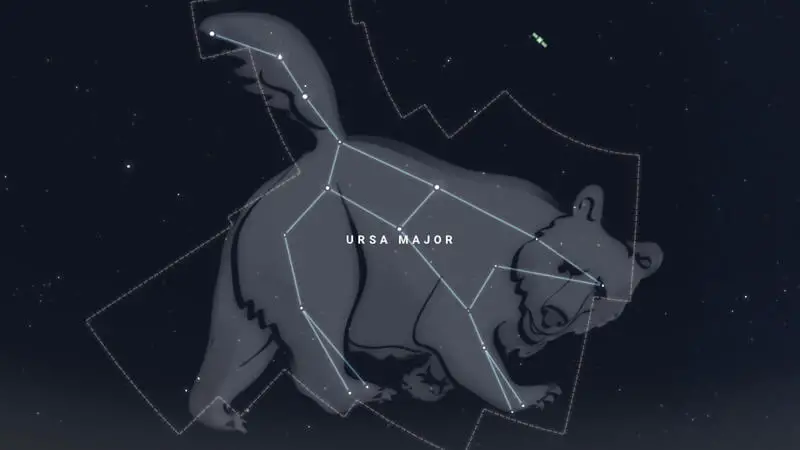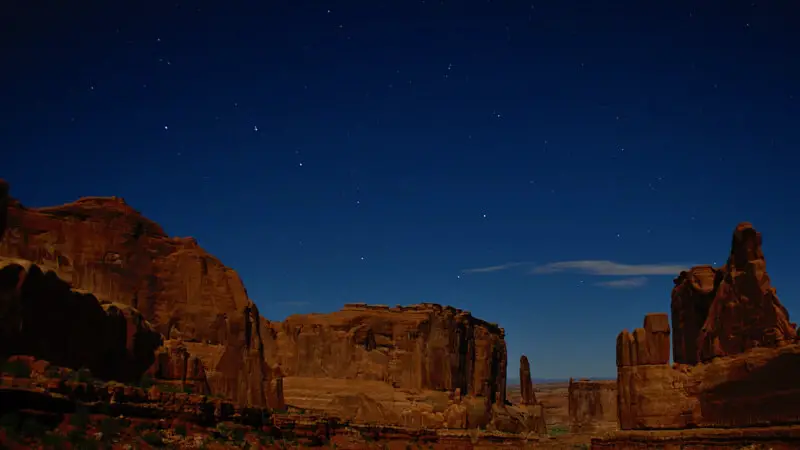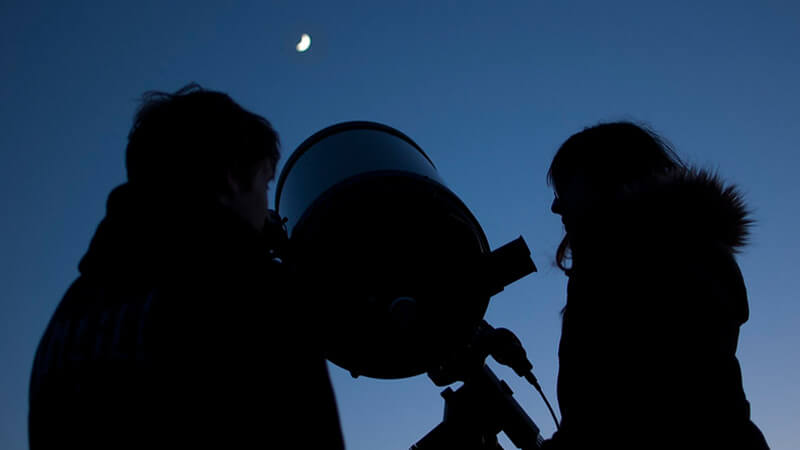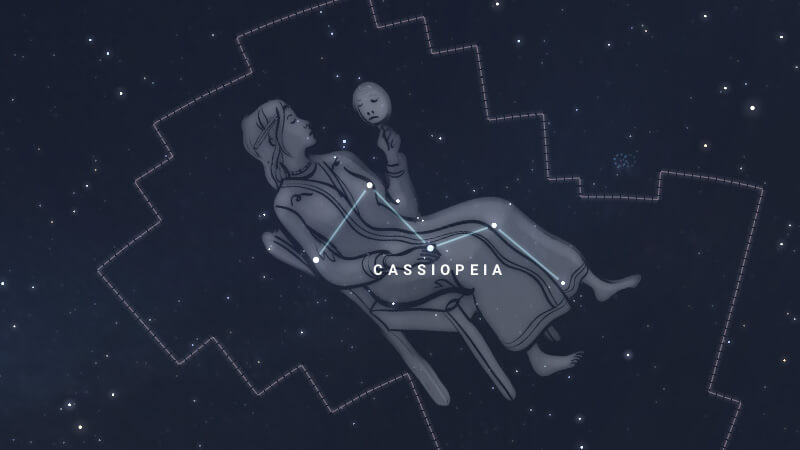As a stargazer, you’ve heard of the famous Big Dipper constellation. This prominent group of stars is visible throughout the year, but can you see the Big Dipper all year?
Yes, you can see the Big Dipper all year (365 days a year) in the Northern Hemisphere. You can see it because the constellation Ursa Major, which contains the Big Dipper, lies in the direction of Earth’s North Pole. For most northern latitudes, the Big Dipper remains visible in the sky throughout the year.
Key Things to Know:
- Visible Every Day of the Year in the Northern Hemisphere: The Big Dipper is a prominent asterism that can be seen throughout the year if you’re in the Northern Hemisphere. Its visibility is due to its position relative to Earth’s North Pole. When gazing up at the night sky, many refer to Ursa Major as “Ursa Major the Greater Bear”
- Part of Ursa Major Constellation: While the Big Dipper is well-known, it’s just a part of a larger constellation called Ursa Major, or the Great Bear. The Big Dipper represents the tail and hindquarters of this celestial bear. The Big Dipper consists of seven prominent stars.
- Position Changes with Seasons: As the year progresses, the orientation of the Big Dipper changes. It rotates counterclockwise around the north celestial pole, circling endlessly around Polaris. Its appearance in the sky will vary depending on the season.
- Best Viewing Tips: Find a location with minimal light pollution and no Moon for optimal viewing. Tilt your head upwards at about a 60-degree angle. The Big Dipper is closer to the horizon during summer and fall, so adjust your gaze accordingly. It should be visible just about every clear night. Using tools like binoculars or stargazing apps can further enhance the experience.
In this article, you get
A close look at the Big Dipper asterism
Information on when and where to observe the Big Dipper
Stargazing tips and a sneak peek at other constellations
By the end of this article, you’ll have all the info you need to see the Big Dipper and much more.
Let’s dive right in.
Recommended For You
Can you see the Big Dipper all year? Understanding the Big Dipper Images

Star Formation
The Big Dipper is an asterism of seven bright stars and is part of a constellation called Ursa Major, the Great Bear. Imagine a huge soup spoon in the sky, and that’s what it looks like.
While focusing on the Big Dipper, it’s also interesting to note the Little Dipper stars, which form another notable asterism in the sky, making up the constellation Ursa Minor. The Big Dipper and Little Dipper both rotate around the North Star.
Let me help you recognize the stars in the Big Dipper:
- Alkaid – the tip of the Dipper’s handle
- Mizar and Alioth – the two middle stars of the handle
- Phecda and Megrez – the two stars connecting the handle to the Dipper’s bowl
- Dubhe and Merak – the two pointer stars at the front of the bowl (The Pointers)
You should now be able to recognize these stars when looking at Big Dipper images. They will also help you find the Little Dipper.
Relation to Ursa Major

The Big Dipper is only a tiny part of the Ursa Major constellation. If you can find the Big Dipper, you can easily spot the rest of Ursa Major. Picture this: The Dipper is the Great Bear’s tail and hindquarters. The front part of the Bear, including its head and legs, extends from the Dipper’s bowl in a bear-like pattern.
Look up on a clear night, and try to spot the Big Dipper using my tips here. Once you’ve found it, use your imagination to complete the Great Bear. Seeing the Big Dipper and Ursa Major will help you appreciate the beauty of these star patterns and the stories they tell in the sky.
How To Find The Big Dipper
You can easily find the Big Dipper in the night sky. This video provides simple and practical tips.
Observing the Big Dipper All Year

In this section, I will help you understand how to spot the Big Dipper throughout the year from different locations and latitudes in the United States.
Location and Season
Good news! If you live in most parts of the United States, you can see the Big Dipper all year. It’s one of the easiest star patterns to locate in the sky and is visible during every season in the Northern Hemisphere.
Remember that the Big Dipper’s orientation changes throughout the year as it rotates counterclockwise around the north celestial pole. So, it might look different in spring than it does in fall.
Big Dipper Visibility in the North
The visibility of the Big Dipper in the Northern Hemisphere depends largely on your latitude.
Is it always above your horizon? Here’s a simple table to illustrate the general visibility of the Big Dipper throughout the year based on different latitudes:
| Latitude | Winter | Spring | Summer | Fall |
|---|---|---|---|---|
| 60°N and above | Visible | Visible | Visible | Visible |
| 50°N – 59°N | Visible | Visible | Visible | Visible |
| 40°N – 49°N | Visible | Visible | Circumpolar (low in the north) | Visible |
| 30°N – 39°N | High in the north | Setting in the northwest | Low in the north | Rising in the northeast |
| 20°N – 29°N | High in the north | Setting in the northwest | Below the horizon | Rising in the northeast |
Effects of Latitude
Latitude affects how easily and when you can see the Big Dipper. If you live north of latitude 41°N, which includes cities like New York, Chicago, and Denver, the Big Dipper will be circumpolar. In simple terms, you can see it every night throughout the year.
For those living further south, the Big Dipper may be harder to spot and will appear lower on the northern horizon. However, it is still visible in almost all parts of the United States.
Here are a few tips to help you spot the Big Dipper:
- Look for a pattern of seven bright stars that form a ladle shape.
- Find a clear, dark sky away from city lights.
- Give your eyes 10 minutes to adjust to the darkness.
- Remember that the Big Dipper’s position changes with the seasons, so keep an eye on its orientation throughout the year. The Big Dipper may appear upside down.
Now that you know how to find the Big Dipper, head outside and enjoy stargazing! Remember to share your discoveries with friends and family.
FREE STARGAZING CHECKLIST
My 5-page Stargazing Checklist will enhance your astronomical observations.
Follow this free checklist to navigate the night sky with confidence, clarity, and a sense of preparedness for a rewarding stargazing experience.

Astronomy for Beginners

Welcome to the fascinating world of stargazing! In this section, I will guide you through the essentials of astronomy, getting started in stargazing, and some valuable equipment and resources. Please sit back, relax, and let’s explore the night sky together.
Getting Started in Stargazing
First, find a dark and comfortable spot away from the light pollution of bright city lights. Being in a dark skies location will help you see fainter celestial objects more easily. Give your eyes 10 minutes to adapt to the darkness to better see the night sky’s wonders.
Next, try to locate constellations like the Big Dipper, which is visible most of the year in the Northern Hemisphere. Use familiar shapes or patterns to help guide your eyes through the stars, and soon you’ll spot celestial wonders like a pro!
Equipment and Resources

Though not required, some tools can enhance your stargazing experience. Here are a few items you might consider:
- Binoculars: A simple and affordable option for beginners.
- Telescope: Provides a closer look at celestial objects but can be costly and requires some skill.
- Star maps or smartphone apps: Help you identify constellations and other celestial objects.
Connect with other stargazers by joining a local astronomy club or attending star parties. Sharing your passion for the night sky with others can make the experience even more rewarding and enjoyable.
Other Significant Constellations
Besides the Big Dipper, other constellations near the Big Dipper are worth checking out during different seasons. Let’s explore Orion the Hunter and Cassiopeia the Queen in this section.
Orion the Hunter

You may have seen the well-known constellation Orion the Hunter, easily noticeable in the night sky during winter.
To find Orion, look for three bright stars in a line, forming the hunter’s belt. Surrounding this belt, you’ll notice two bright stars above and two below, representing Orion’s shoulders and legs.
Spend some time observing Orion, and you might spot its famous nebula, the Orion Nebula, which appears as a faint, cloudy patch near the belt. It’s an incredible sight to enjoy on a clear, dark night and can even be seen with binoculars.
Can you see Orion and the Big Dipper at the same time?
Orion is typically more prominent in the winter months, while the Big Dipper is visible year-round. During late winter or early spring, you can often observe Orion in the evening sky, while the Big Dipper may also be visible, depending on the time and your location. In general, both constellations can be seen in the night sky, but their relative positions change throughout the year.
Cassiopeia the Queen

Cassiopeia the Queen is another fascinating constellation, visible throughout the year in the northern sky.
To find Cassiopeia, search for a “W” or “M” shaped pattern of bright stars, depending on its orientation in the sky. This distinctive pattern makes it easy to spot, even for beginners.
As you watch the sky over time, you’ll notice that Cassiopeia and the Big Dipper appear to rotate around Polaris, the North Star. This rotation means that Cassiopeia may be higher or lower in the sky depending on the time of year than the Big Dipper.
Enjoy your stargazing journey! The constellations Orion the Hunter and Cassiopeia the Queen are worth your attention.
Keep exploring the night sky; you’ll discover many more constellations and celestial objects that will bring you closer to the universe’s wonders.
Frequently Asked Questions
When can you see the Big Dipper?
You can see the Big Dipper all year round. The best time to see it is during spring and summer. During these seasons, the Big Dipper is visible throughout the night. You can easily spot it in the northern sky, and it’s an excellent constellation to observe with the naked eye.
Is the Big Dipper always visible?
The visibility of the Big Dipper depends on your location and the time of year. In the northern hemisphere, it is a circumpolar constellation, always above the horizon, making it visible year-round. However, its position in the sky varies with the seasons, appearing higher in the northern sky during spring and summer and lower during fall and winter.
Why is the Big Dipper always visible?
The Big Dipper is always visible in many parts of the Northern Hemisphere because it’s circumpolar, meaning it revolves around Polaris, the North Star, without setting or rising. Its position relative to Polaris keeps it above the horizon for viewers at higher northern latitudes.
What month is the Big Dipper most visible?
The Big Dipper is most visible during April, May, and June. During these months, the constellation is high in the sky and visible most of the night. This makes it an ideal time to observe the Big Dipper and its stars.
Will the Big Dipper ever go away?
No, the Big Dipper will never go away. It’s a permanent feature of our night sky and has been visible for thousands of years. However, its position in the sky changes over time due to the movement of the Earth and the stars. So, while it may appear to move or shift slightly over time, it will always be visible in some form.
Why is the Big Dipper so important?
The Big Dipper is important for a few reasons. It’s one of the most recognizable constellations in the sky, making it a great starting point for anyone interested in astronomy. It’s part of the Ursa Major constellation, one of the sky’s largest and most prominent constellations. The Big Dipper has been used for navigation for thousands of years, making it an essential tool for travelers and explorers.
Is the Big Dipper in the Milky Way?
Yes, the Big Dipper is in the Milky Way galaxy. It’s a part of our galaxy and is relatively close to us compared to many other stars and constellations. While it may not be as visually striking as some other features of the Milky Way, it’s still an important part of our galactic neighborhood.
Summary: when is the big dipper visible?
So, can you always see the Big Dipper? The answer is yes, you can! Whether you’re an experienced stargazer or a beginner, the Big Dipper constellation is a great constellation to observe and learn about. It’s visible throughout the year, making it a reliable and consistent night sky feature.
Looking at the Big Dipper, you see a part of history. This constellation has been visible for thousands of years and has been used for navigation and storytelling by cultures worldwide. Observing it yourself connects with a long and rich human exploration and curiosity tradition.
Not only is the Big Dipper a critical part of our cultural and historical heritage, but it’s also a beautiful and awe-inspiring sight. Its seven bright stars are easy to spot and make for a striking image against the night sky. The Big Dipper will inspire and humble you, whether observing it with the naked eye or through a telescope.
So, take some time to observe the Big Dipper for yourself. With just a little patience and curiosity, you can spot this iconic constellation and unlock the secrets of the night sky.
Whether you’re out in the countryside or just looking up from your backyard, it’s a great way to connect with the natural world and gain a deeper appreciation for the wonders of our universe.
So go ahead, grab a blanket and a hot drink, and get ready to explore the Big Dipper – you won’t be disappointed!
Additional articles you may enjoy in my Big Dipper series:




